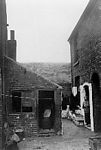In 1925 a "terrible state of affairs" was reported by a Dudley councillor who visited 600 houses in St Thomas' ward and found them "in a most deplorable state?half of them not fit to live in".
Many overcrowded "court" houses and back-to-backs dated from the 1850s, these were small, cheaply built and damp. There was shared usage of water taps and sanitary accommodation, all of which were often substandard. Added to this there was overcrowding within individual houses, as well as overcrowding of the built environment in the first place. These were all prominent features of the working class housing in this area.
Consequently, after the First World War greater demand to eradicate back-to-backs and create a new from of housing increased. Building houses of iron would therefore increase the iron industry.
The houses standing on the Museum site are No. 112 and No. 114 Birmingham Road. These houses were the first of the four to be built. They were completed in November/December of 1925. The houses on Ernest Road, were built a year later, or in the first months of 1927.
The rent is thought to have been around 10 to 12 shillings. It must be remembered that these council houses were expensive for the lower social classes and although they were initially intended to be houses for the working classes, most would not be able afford to live in them. A typical complaint of the cast iron houses were that they were freezing in the winter and like ovens in the summer.
Rollover the captions in the box to see the available images in thumbnail format, click the caption to see the full-size image
| Reference: | 134 |
| Keywords: | Iron House Back to Back Cheap War 1850 Sanitary Conditions 1920s MCOL BCLM |
| Archive Ref: | Marketing Photographic Collection and Project File |
| Updated: | 11/9/2001 15:58:34 |



